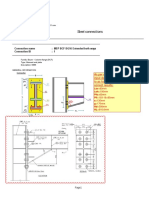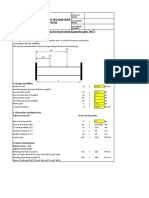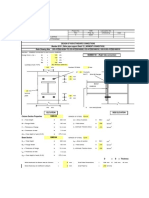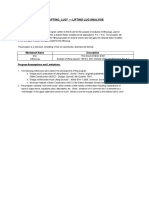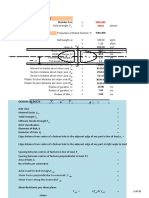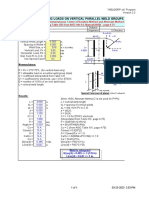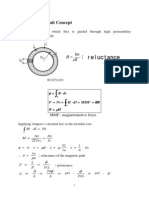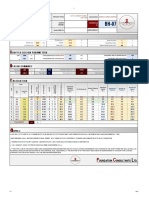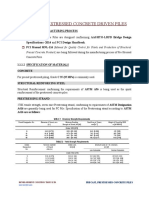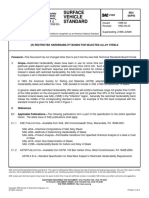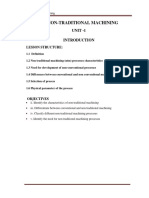Eccentric Loads On Vertical Parallel Weld Groups
Uploaded by
Priodeep ChowdhuryEccentric Loads On Vertical Parallel Weld Groups
Uploaded by
Priodeep Chowdhury"WELDGRP.
xls" Program
Version 2.1
ECCENTRIC LOADS ON VERTICAL PARALLEL WELD GROUPS
Based on the Instantaneous Center of Rotation Method and Alternate Method 2
Using Table XIX from AISC 9th Ed. Manual (ASD) - page 4-75
Job Name: HOLCIM JETTY EXTENSION PROJECT Subject: Check for Welding of Bracket
Job Number: Originator: Priodeep Checker:
Pv=2.5 k
Input Data: aL=3 q =0
Vertical Weld Length = 1.500 in. P=Pv
Spacing of Welds = 3.000 in.
Weld Size, w = 3/16 in. = 3 (1/16's) L=
Vertical Load, Pv = 2.50 kips 1.500 C.G. Ph=0
Horizontal Load, Ph = 0.00 kips
Dist. from Pv to C.G. = 3.000 in.
Use Special Case? No (kL)/2 (kL)/2
kL= 3
Nomenclature:
10MM THICK WELD
Pv
P = Pv = C*C1*D*L (for vertical load only) q
P = allowable load on eccentric weld group (kips) aL
C = coefficient interpolated from Table XIX P
C1 = coefficient for electrode, use 1.0 for E70XX
D = number of 1/16's of an inch (weld size) L
L = vertical weld length Ph
eq. spaces
Special Case (out of plane) (Use C values for k=0)
Results:
(Note: AISC Alternate Method 2 is not used for P=Pv)
L= 1.500 in. L = vertical weld length
kL = 3.000 in. kL = spacing of vertical welds
aL = 3.000 in. aL = dist. from Pv to C.G.
a= 2.000 a = (aL)/L
k= 2.000 k = (kL)/L
C1 = 1.0 C1 = 1.0 for E70XX electrode
C= 0.642 (interpolated from Table XIX, page 4-75)
P= 2.50 kips P = SQRT(Pv^2+Ph^2)
Angle q = 0.000 deg. q = 90-(ATAN(Pv/Ph))
Co = N.A. Co = C (from AISC Table XIX, page 4-75)
C(max) = N.A. C(max) = 0.928*(2)
A= N.A. A = C(max)/Co >= 1.0
Ca/Co = N.A. Ca/Co = A/(SINq+A*COSq) >= 1.0
Ca = N.A. Ca = (Ca/Co)*Co
D(req'd) = 2.596 1/16's D(req'd) = P/(C*C1*L)
L(req'd) = 1.298 in. L(req'd) = P/(C*C1*D)
Weld is adequate!
D(req'd) = 2.596 <= 3 (1/16's)
L(req'd) = 1.298 <= 1.5 in.
1 of 1 11/16/2019 1:07 PM
You might also like
- Method Statement For Demolition of Pile Cap of Existing Dolphin Jetty100% (1)Method Statement For Demolition of Pile Cap of Existing Dolphin Jetty5 pages
- Lifting Lug Load Capacity Vs Crack Length CalculationNo ratings yetLifting Lug Load Capacity Vs Crack Length Calculation26 pages
- Weld Design Under Axial, Moment and Shear ForcesNo ratings yetWeld Design Under Axial, Moment and Shear Forces3 pages
- A. Check For Compression: DESIGN USING ASME BTH1-2005 - Code For LiftingNo ratings yetA. Check For Compression: DESIGN USING ASME BTH1-2005 - Code For Lifting6 pages
- Structural Calculation Report of Platform Str-2No ratings yetStructural Calculation Report of Platform Str-291 pages
- 68 36 300-1-SEABC C13 Session 4 Stability 2PerPageColorNo ratings yet68 36 300-1-SEABC C13 Session 4 Stability 2PerPageColor127 pages
- Vertical Bracing With End Plate Connection100% (1)Vertical Bracing With End Plate Connection85 pages
- Lashing Lug Round Bar Design: 1. GeneralNo ratings yetLashing Lug Round Bar Design: 1. General3 pages
- PDF Moment Connection Beam Column Is Amp Bs Section For Is800xls CompressNo ratings yetPDF Moment Connection Beam Column Is Amp Bs Section For Is800xls Compress29 pages
- CEN TOOL Standard Padeyes V4 Rollup Padeye Sheave100% (1)CEN TOOL Standard Padeyes V4 Rollup Padeye Sheave5 pages
- Brackets For Circular Platforms at Vertical VesselsNo ratings yetBrackets For Circular Platforms at Vertical Vessels4 pages
- Specialist Services: Force Resolution CalculationNo ratings yetSpecialist Services: Force Resolution Calculation5 pages
- Beam Deflections and Stresses During Lifting PDFNo ratings yetBeam Deflections and Stresses During Lifting PDF10 pages
- Spreader Beam or Lifting Beam - An Explanation For All - LinkedInNo ratings yetSpreader Beam or Lifting Beam - An Explanation For All - LinkedIn4 pages
- Design of Temporary Horizontal Life Line (HLL) A. Material Properties Steel Member0% (1)Design of Temporary Horizontal Life Line (HLL) A. Material Properties Steel Member2 pages
- Stress Based Topology Optimization of 30 Ton C Hook Using FEM.100% (1)Stress Based Topology Optimization of 30 Ton C Hook Using FEM.48 pages
- Steel Member Analysis & Design - Sample Calculation (As 4100)No ratings yetSteel Member Analysis & Design - Sample Calculation (As 4100)9 pages
- Lifting Lug Design Per ASME BTH-1-2005: InputNo ratings yetLifting Lug Design Per ASME BTH-1-2005: Input4 pages
- Eccentric Loads On Rectangular Weld GroupsNo ratings yetEccentric Loads On Rectangular Weld Groups1 page
- Reluctance: I. Magnetic Circuit ConceptNo ratings yetReluctance: I. Magnetic Circuit Concept12 pages
- MIN Esign & Onsultancy.: Client Project LocationNo ratings yetMIN Esign & Onsultancy.: Client Project Location1 page
- Job Information: Engineer Checked ApprovedNo ratings yetJob Information: Engineer Checked Approved5 pages
- Design Report On Construction of Jetty For 10000DWT Vessel100% (1)Design Report On Construction of Jetty For 10000DWT Vessel11 pages
- Name of The Project: Construction of 335MW CCPP at Meghnaghat, Narayangonj. Name of The Client: NECPNo ratings yetName of The Project: Construction of 335MW CCPP at Meghnaghat, Narayangonj. Name of The Client: NECP1 page
- Project Name: BISTAAR Name of Client: Holcim (Bangladesh) LTDNo ratings yetProject Name: BISTAAR Name of Client: Holcim (Bangladesh) LTD2 pages
- Precast Pile Analysis For Lifting 29m Long 26.11No ratings yetPrecast Pile Analysis For Lifting 29m Long 26.111 page
- Pile Design: Registered User: © 2018 CivilwebNo ratings yetPile Design: Registered User: © 2018 Civilweb1 page
- Method Statement For Manufacturing and Standard Specifications For P.C PilesNo ratings yetMethod Statement For Manufacturing and Standard Specifications For P.C Piles2 pages
- Precast Prestressed Concrete Driven PilesNo ratings yetPrecast Prestressed Concrete Driven Piles3 pages
- Capacity Estimate of The Underreamed Pile: Skin Friction (Ultimate)No ratings yetCapacity Estimate of The Underreamed Pile: Skin Friction (Ultimate)1 page
- Development Constructions LTD.: Construction Methodology - (On Land) For Jetty Extension Project at Meghnaght-01No ratings yetDevelopment Constructions LTD.: Construction Methodology - (On Land) For Jetty Extension Project at Meghnaght-016 pages
- Magnetic Particle Inspection: NDT Service - Marine Consultant - Engineering ServiceNo ratings yetMagnetic Particle Inspection: NDT Service - Marine Consultant - Engineering Service4 pages
- Overview of The TOX - Clinching Technology: StrengthNo ratings yetOverview of The TOX - Clinching Technology: Strength24 pages
- Fixture Design: Introduction To Jigs and Fixtures100% (1)Fixture Design: Introduction To Jigs and Fixtures10 pages
- MSE658A: Simulation of Hall-Petch RelationshipNo ratings yetMSE658A: Simulation of Hall-Petch Relationship11 pages
- Surface Vehicle Standardsta Ndard: Rev. DEC83100% (1)Surface Vehicle Standardsta Ndard: Rev. DEC8311 pages
- Forms of Corrosion: CHE-545-172 DR Ime B.ObotNo ratings yetForms of Corrosion: CHE-545-172 DR Ime B.Obot17 pages
- Coke Drum Repair Welch Aquilex WSI DCU Calgary 2009No ratings yetCoke Drum Repair Welch Aquilex WSI DCU Calgary 200937 pages
- Surface & Coatings Technology: A. Azimi, F. Ashra Fizadeh, M.R. Toroghinejad, F. ShahriariNo ratings yetSurface & Coatings Technology: A. Azimi, F. Ashra Fizadeh, M.R. Toroghinejad, F. Shahriari8 pages
- Compilation of Elements in Machine Design I100% (1)Compilation of Elements in Machine Design I21 pages
- 05) - Process Flow Diagram For 11190722 - DNo ratings yet05) - Process Flow Diagram For 11190722 - D2 pages
- 26071-100-VSC-ME3-4-50003 - Sand Blasting & Painting Procedure. Rev. 00ANo ratings yet26071-100-VSC-ME3-4-50003 - Sand Blasting & Painting Procedure. Rev. 00A64 pages
- DETAIL-'1': SECTION '6-6' (Showing Reinf.) SECTION '5-5' (Showing Reinf) Typical Detail of Hand Rail at FobNo ratings yetDETAIL-'1': SECTION '6-6' (Showing Reinf.) SECTION '5-5' (Showing Reinf) Typical Detail of Hand Rail at Fob1 page
- 00 - Propriedades Do Cobre (WWW - Copper - Org)100% (1)00 - Propriedades Do Cobre (WWW - Copper - Org)114 pages





